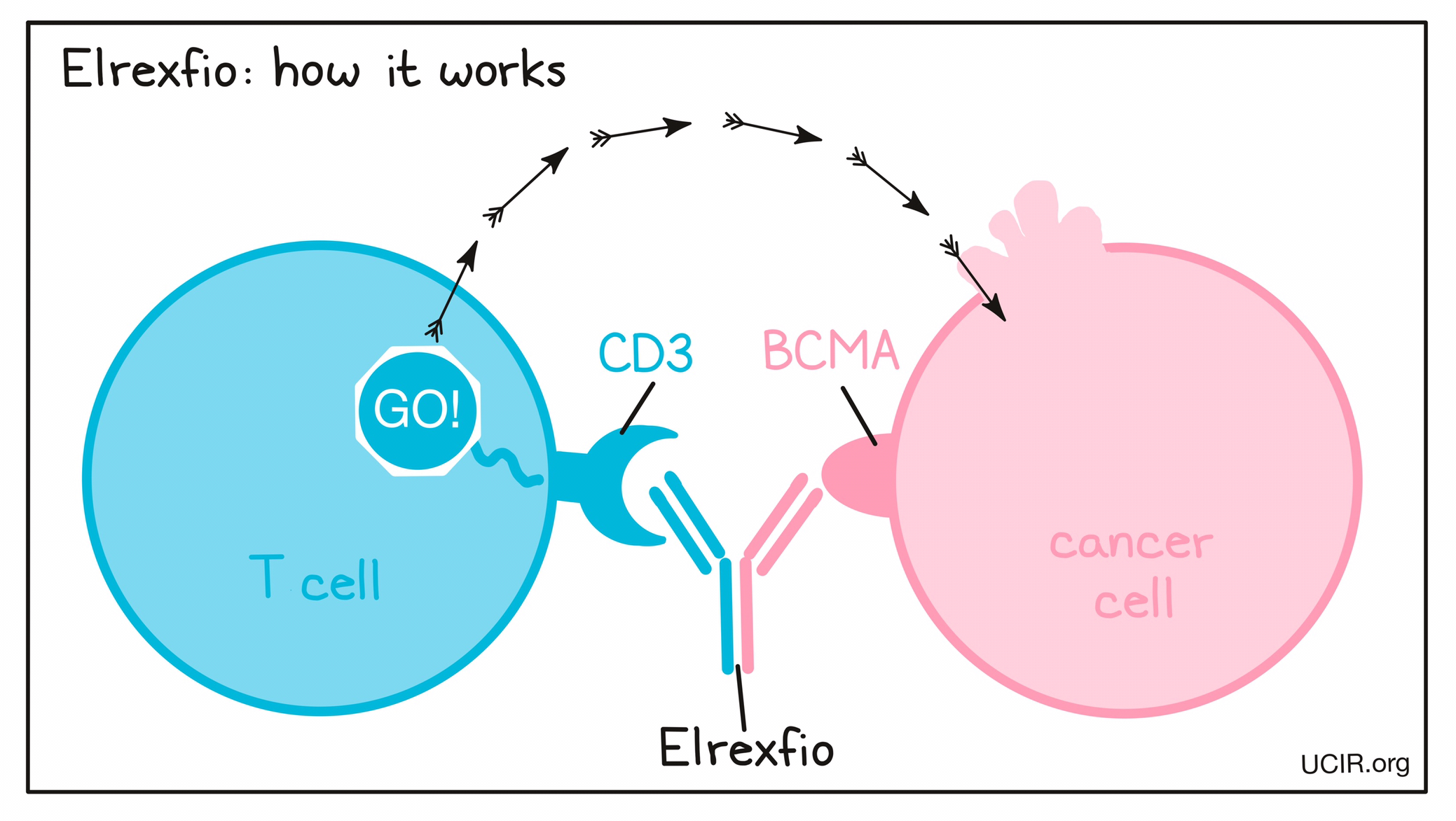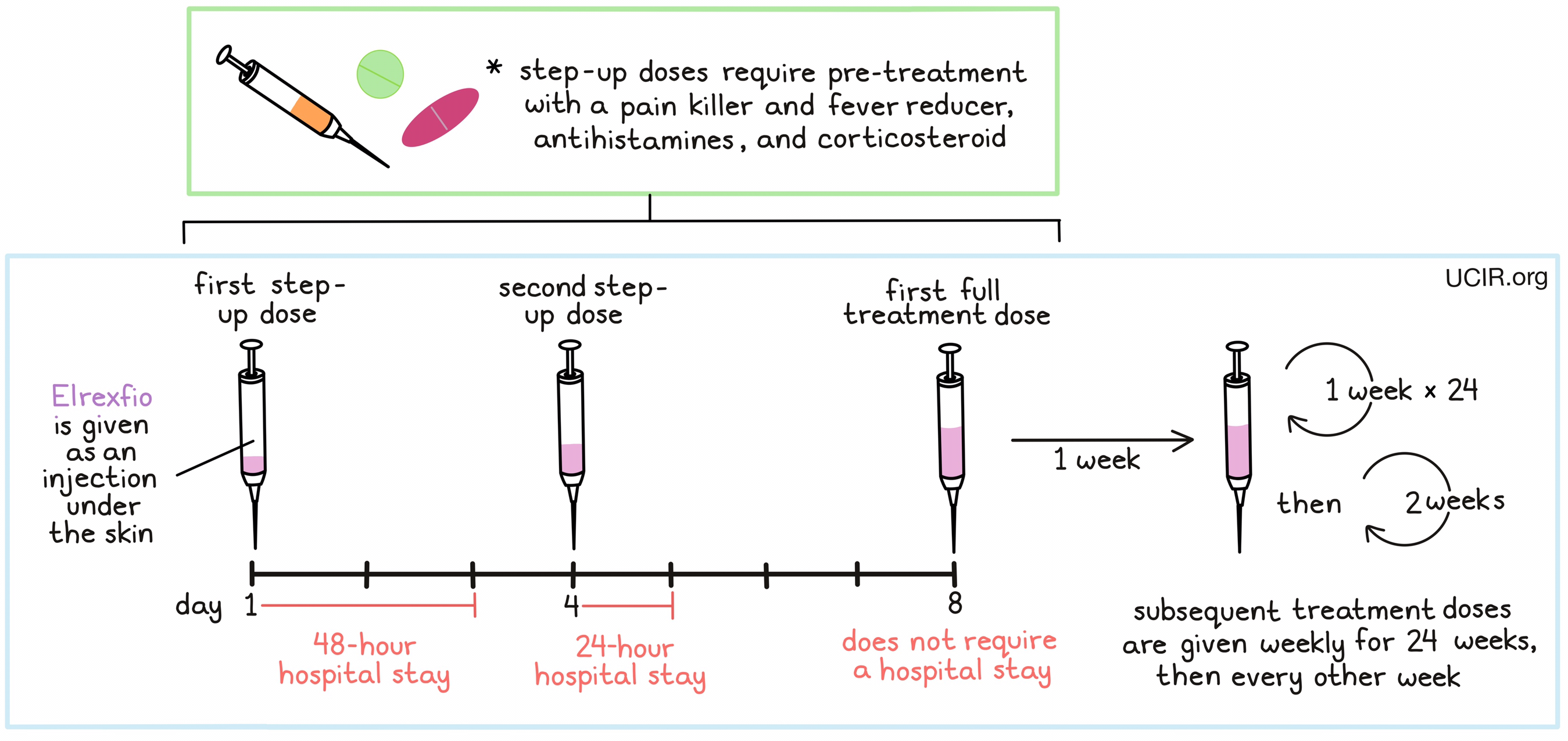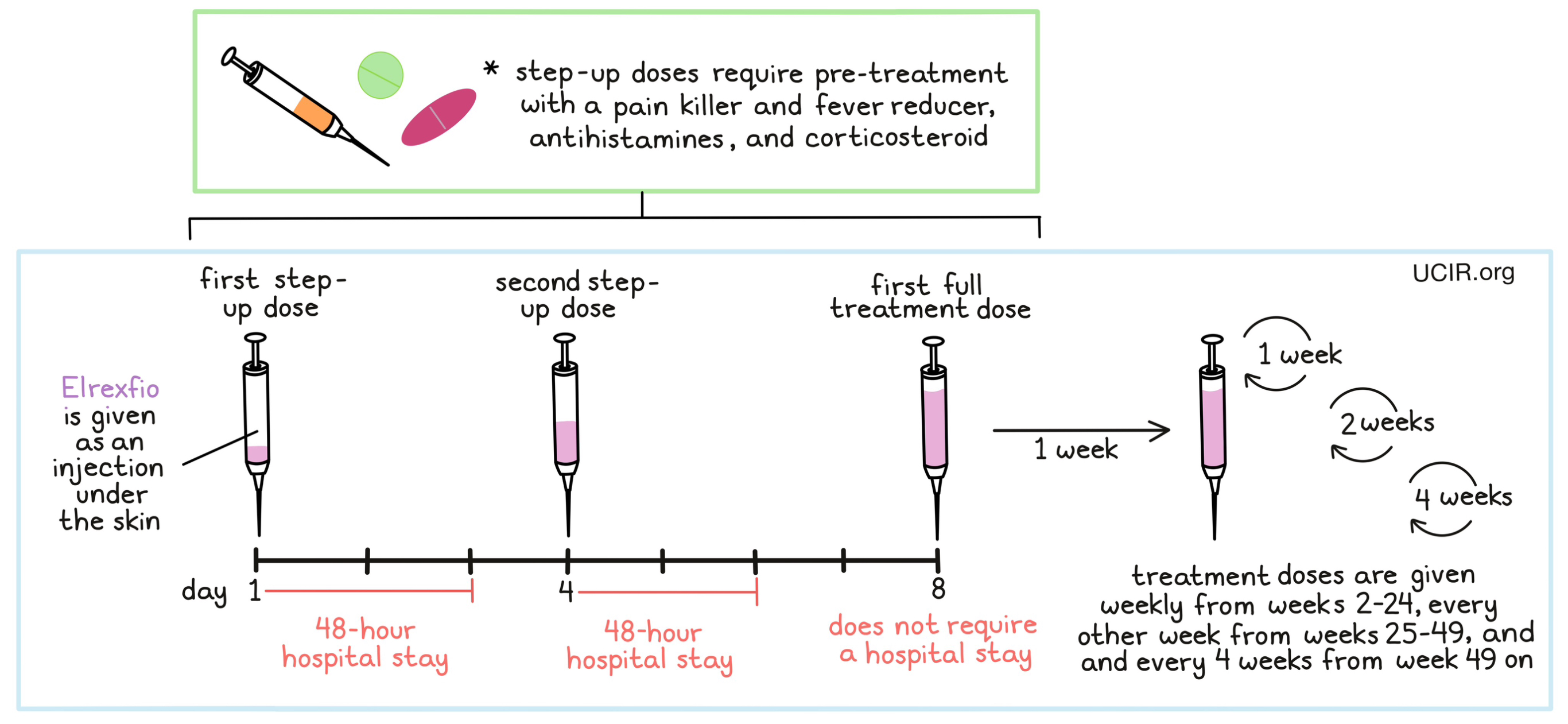How is this drug name pronounced?
Elranatamab: El-rah-NAH-tah-mab
Elrexfio: El-REKS-fee-oh
What cancer(s) does this drug treat?
Multiple Myeloma (MM)
Elrexfio is approved for:
- Patients with diffuse multiple myeloma who have received at least four prior treatments for their disease, including a proteasome inhibitor, an immunomodulatory agent, and an anti-CD38 antibody (e.g., daratumumab (Darzalex) or isatuximab-irfc (Sarclisa)), but whose cancer either did not respond to treatment (refractory) or has since come back (relapsed).
Limitations of use
Limitations: Elrexfio should only be administered in a treatment center and by adequately trained healthcare professionals who can ensure proper monitoring and immediate management of side effects associated with the drug.
Age: The safety and efficacy of Elrexfio in patients under 18 years of age have not been established.
Pregnancy/Breastfeeding: Elrexfio is not recommended for use during pregnancy due to potential for harm to the fetus. Patients who can become pregnant are advised to use contraception during treatment with Elrexfio and for 4 months after the last dose of Elrexfio. The risks associated with Elrexfio during breastfeeding are not known and cannot be ruled out. Due to the potential for adverse reactions in the breastfed child, patients are advised not to breastfeed during treatment with Elrexfio and for 4 months after the last dose of Elrexfio.
Interactions with other drugs: Dose adjustments may become necessary for patients treated with certain CYP substrates at the start of treatment with Elrexfio.
What type of immunotherapy is this?
How does this drug work?
Targets:
- BCMA on plasma cells, plasmablasts, and multiple myeloma cells
- CD3 receptor on T cells
Elrexfio is a “bispecific antibody”. Antibodies are molecules that can bind to a particular target molecule. Bispecific antibodies are artificially made in the laboratory and can bind to two different targets at the same time. Elrexfio binds to:
- a molecule called BCMA on the surface of plasma cells, plasmablasts, and multiple myeloma cells. BCMA is present at much higher quantities on the surface of cancer cells than normal healthy cells.
- a molecule called CD3 on the surface of T cells – the primary immune cells involved in killing cancer cells. CD3 is part of the T cell receptor, which is critical to the function of the T cell and is involved in stimulating the T cell to become active.
Because Elrexfio can bind to one molecule on multiple myeloma cells and another on T cells at the same time, it acts as a bridge and keeps the T cell in close contact with the cancer cell. By binding CD3 on the T cell, Elrexfio also stimulates the T cell to become activated and kill the cell it is bound to. Bispecific antibodies that direct T cells to kill cancer cells by binding to both cells at the same time are known as bispecific T cell engagers (BiTEs).

How is the drug given to the patient?
Elrexfio is given as an injection just below the skin (subcutaneous injection) in the lower part of the abdomen or the thigh. To start, a small dose of Elrexfio is given on day 1, followed by a larger dose on day 4, and a full treatment dose on day 8. This “step-up” dosing schedule helps to reduce the risk of a reaction to Elrexfio. The first step-up dose requires a 48-hour hospital stay, and the second step-up dose requires a 24-hour hospital stay to monitor for potentially serious reactions to treatment. Additionally, during step-up dosing, patients receive several medications approximately 1 hour prior to each dose of Elrexfio to help reduce the risk of cytokine release syndrome (a common and potentially severe side effect of Elrexfio treatment):
- A corticosteroid (dexamethasone)
- An antihistamine (diphenhydramine)
- A painkiller and fever reducer (acetaminophen)
After step-up dosing is complete, patients receive Elrexfio on a weekly basis for 24 weeks. For patients who have achieved and maintained a response to treatment at 25 weeks, Elrixio is then given every other week.

What are the observed clinical results?
It is important to keep in mind that each patient’s outcome is individual and may be different from the results found in the clinical studies.
Multiple Myeloma
In a clinical study, 97 patients with multiple myeloma who had received at least four prior treatments for their disease, including a proteasome inhibitor, an immunomodulatory agent, and an anti-CD38 antibody (e.g., daratumumab (Darzalex) or isatuximab-irfc (Sarclisa)), but whose cancer either did not respond to treatment or has since come back, were treated with Elrexfio. The median time to first response was one month. At a median follow-up of 11 months:

What are the potential side effects?
The most common side effects of Elrexfio include cytokine release syndrome, fatigue, reactions at the injection site, diarrhea, upper respiratory tract infection, pain in the joints, muscles, or bones, pneumonia, decreased appetite, rash, cough, nausea, fever, and abnormal blood and liver test results. Some side effects, such as cytokine release syndrome, immune effector cell-associated neurotoxicity syndrome, other neurologic toxicities, infections, low white blood cell counts (neutropenia), and liver toxicity/damage can become serious or life-threatening. Patients and caregivers receive careful instructions to monitor for signs and symptoms of side effects. These conditions are managed by the healthcare provider.
Cytokine release syndrome (CRS)
CRS is caused by a widespread release of molecules called cytokines, which can cause inflammation and can affect the function of various organs. Cytokines may be released by the T cells to which Elrexfio binds, or by other immune cells in the patient’s body. Signs and symptoms of CRS include fever, low blood pressure, hypoxia (low oxygen levels), fast heartbeat rate, shortness of breath, chills, headache, and elevated liver enzymes. CRS typically occurs within hours or a few days after the first or second step-up dose of Elrexfio in treatment cycle 1. A healthcare provider should be immediately notified if symptoms occur.
Immune effector cell-associated neurotoxicity syndrome (ICANS)
Some of the cytokines released during CRS can result in disruption of the blood–brain barrier, leading to the development of neurological toxicities. ICANS typically occurs within 4 days after the most recent dose of Elrexfio in treatment cycle 1. Symptoms of ICANS include shaking, problems with movement, lethargy, seizures, confusion, and difficulty with speech or handwriting. A healthcare provider should be immediately notified if symptoms occur.
For a more complete list of possible side effects, see the full prescribing information.
Manufacturer
Pfizer Inc.
Approval
FDA and EMA
Links to drug websites
Last updated: March 20, 2024
How is this drug name pronounced?
Elranatamab: El-rah-NAH-tah-mab Elrexfio: El-REKS-fee-oh
What cancer(s) does this drug treat?
Multiple Myeloma (MM)
Elrexfio is approved for:
- Patients with multiple myeloma who have received at least three prior treatments for their disease, including a proteasome inhibitor, an immunomodulatory agent, and an anti-CD38 antibody (e.g., daratumumab (Darzalex) or isatuximab-irfc (Sarclisa)), but whose cancer either did not respond to treatment (refractory) or has since come back (relapsed).
Limitations of use
Limitations: Elrexfio should only be administered in a treatment center and by adequately trained healthcare professionals who can ensure proper monitoring and immediate management of side effects associated with the drug.
Age: The safety and efficacy of Elrexfio in patients under 18 years of age have not been established.
Pregnancy/Breastfeeding: Elrexfio is not recommended for use during pregnancy due to potential for harm to the fetus. Patients who can become pregnant are advised to use contraception during treatment with Elrexfio and for 6 months after the last dose of Elrexfio. The risks associated with Elrexfio during breastfeeding are not known and cannot be ruled out. Due to the potential for adverse reactions in the breastfed child, patients are advised not to breastfeed during treatment with Elrexfio and for 6 months after the last dose of Elrexfio.
Live virus vaccines: Vaccination with live virus vaccines is not recommended within the 4 weeks prior to the first dose, during treatment, and at least 4 weeks after treatment with Elrexfio.
Interactions with other drugs: Dose adjustments may become necessary for patients treated with certain CYP substrates at the start of treatment with Elrexfio.
Driving and operating machinery: Patients should refrain from driving or operating heavy or potentially dangerous machinery for 48 hours after completing each of the 2 step-up doses. If new neurologic symptoms occur, patients should refrain from these activities until their symptoms resolve.
What type of immunotherapy is this?
How does this drug work?
Targets:
- BCMA on plasma cells, plasmablasts, and multiple myeloma cells
- CD3 receptor on T cells
Elrexfio is a “bispecific antibody”. Antibodies are molecules that can bind to a particular target molecule. Bispecific antibodies are artificially made in the laboratory and can bind to two different targets at the same time. Elrexfio binds to:
- a molecule called BCMA on the surface of plasma cells, plasmablasts, and multiple myeloma cells. BCMA is present at much higher quantities on the surface of cancer cells than normal healthy cells.
- a molecule called CD3 on the surface of T cells – the primary immune cells involved in killing cancer cells. CD3 is part of the T cell receptor, which is critical to the function of the T cell and is involved in stimulating the T cell to become active.
Because Elrexfio can bind to one molecule on multiple myeloma cells and another on T cells at the same time, it acts as a bridge and keeps the T cell in close contact with the cancer cell. By binding CD3 on the T cell, Elrexfio also stimulates the T cell to become activated and kill the cell it is bound to. Bispecific antibodies that direct T cells to kill cancer cells by binding to both cells at the same time are known as bispecific T cell engagers (BiTEs).

How is the drug given to the patient?
Elrexfio is given as an injection just below the skin (subcutaneous injection) in the lower part of the abdomen or the thigh. To start, a small dose of Elrexfio is given on day 1, followed by a larger dose on day 4, and a full treatment dose on day 8. This “step-up” dosing schedule helps to reduce the risk of a reaction to Elrexfio. The first two step-up doses each require a 48-hour hospital stay to monitor for potentially serious reactions to treatment. Additionally, during step-up dosing, patients receive several medications approximately 1 hour prior to each dose of Elrexfio to help reduce the risk of cytokine release syndrome (a common and potentially severe side effect of Elrexfio treatment):
- A corticosteroid (dexamethasone)
- An antihistamine (diphenhydramine)
- A painkiller and fever reducer (paracetamol)
After step-up dosing is complete, patients receive Elrexfio on a weekly basis for 24 weeks. For patients who have achieved and maintained a response to treatment at 25 weeks, Elrexfio is then given every other week, and every four weeks from week 49 onward.

What are the observed clinical results?
It is important to keep in mind that each patient’s outcome is individual and may be different from the results found in the clinical studies.
Multiple Myeloma
In a clinical study, 123 patients with multiple myeloma who had received at least three prior treatments for their disease, including a proteasome inhibitor, an immunomodulatory agent, and an anti-CD38 antibody (e.g., daratumumab (Darzalex) or isatuximab-irfc (Sarclisa)), but whose cancer either did not respond to treatment or has since come back, were treated with Elrexfio. The median time to first response was one month. At a median follow-up for 28 months:

What are the potential side effects?
The most common side effects of Elrexfio include cytokine release syndrome, low red blood cell counts (anemia), fatigue, upper respiratory tract infections, reactions at the injection site, diarrhea, upper respiratory tract infection/pneumonia, abnormal white blood cell counts, decreased appetite, fever, rash, pain in the joints, muscles, or bones, nausea, dry skin, and shortness of breath.
Some side effects, such as cytokine release syndrome, immune effector cell-associated neurotoxicity syndrome, other neurologic toxicities, infections, and low white blood cell counts (neutropenia) can become serious or life-threatening. Patients and caregivers receive careful instructions to monitor for signs and symptoms of side effects. These conditions are managed by the healthcare provider.
Cytokine release syndrome (CRS) CRS is caused by a widespread release of molecules called cytokines, which can cause inflammation and can affect the function of various organs. Cytokines may be released by the T cells to which Elrexfio binds, or by other immune cells in the patient’s body. Signs and symptoms of CRS include fever, low blood pressure, hypoxia (low oxygen levels), fast heartbeat rate, shortness of breath, chills, headache, and elevated liver enzymes. CRS typically occurs within hours or a few days after the first or second step-up dose of Elrexfio in treatment cycle 1. A healthcare provider should be immediately notified if symptoms occur.
Immune effector cell-associated neurotoxicity syndrome (ICANS) Some of the cytokines released during CRS can result in disruption of the blood–brain barrier, leading to the development of neurological toxicities. ICANS typically occurs within 4 days after the most recent dose of Elrexfio in treatment cycle 1. Symptoms of ICANS include shaking, problems with movement, lethargy, seizures, confusion, and difficulty with speech or handwriting. A healthcare provider should be immediately notified if symptoms occur.
Infections Elrexfio can alter the immune system, leaving patients more vulnerable to infections. Severe, life-threatening, or fatal infections have been reported in patients receiving Elrexfio.
For a more complete list of possible side effects, see the full prescribing information.
Manufacturer
Pfizer Inc.
Approval
FDA and EMA
Links to drug websites
Last updated: October 10, 2025







